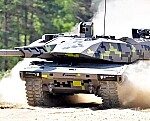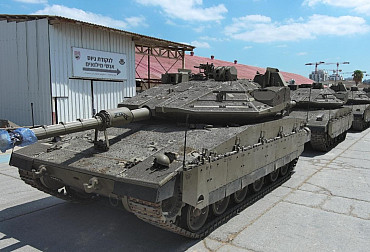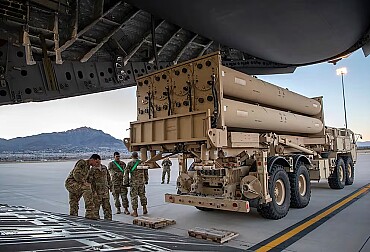Elbit Systems Joins the Australian AS21 Redback Program
The defense landscape is evolving rapidly, and the recent collaboration between Israeli company Elbit Systems and South Korean Hanwha Aerospace in the Australian AS21 Redback program is a testament to this evolution.
In the ever-evolving world of defense technology, collaborations between global giants can lead to groundbreaking advancements. The recent partnership between Israeli company Elbit Systems and South Korean Hanwha Aerospace in the Australian AS21 Redback program is a shining example of such synergy.

A New Era for Australian Defense
On August 16, Elbit Systems proudly announced its role as a subcontractor to Hanwha Aerospace, and more specifically, its subsidiary Hanwha Defense Australia. This collaboration is part of the Australian Mounted Close Combat Capability LAND 400 Phase 3 program. The primary objective? To supply the Australian military with 129 state-of-the-art AS21 Redback infantry fighting vehicles, complemented by technical support vehicles. The combined expertise of Team Redback, which includes Elbit and several other defense companies, clinched the contract on July 27. With an estimated value of AUD 5-7 billion (PLN 13.5-18.9 billion), this program represents a significant investment in Australia's defense capabilities.
Elbit's Pivotal Role
While discussions continue regarding the exact division of roles and responsibilities within the program, Elbit Systems' contribution is crystal clear. They are entrusted with the delivery of the two-person Redback Turret system, known as the T2000. This advanced turret system is a progression from the MT30 Mk 2 and will be packed with cutting-edge features:
- Firepower: A formidable 30-mm automatic cannon (Mk44S Bushmaster II) ensures the vehicle's offensive capabilities.
- Advanced Optics: The turret will feature COAPS gunner's sights and other optoelectronic systems, providing enhanced visibility and targeting accuracy.
- Protection: The Iron Fist - Light active protection system offers an added layer of defense against threats.
- Augmented Reality: The Elbit Systems Iron Vision helmet-mounted targeting set for commanders and drivers uses the STA (See Through Armor) augmented reality technology, offering a futuristic combat experience.
- Detection: ELAWS laser detection systems will provide early warning against potential laser-guided threats.
Moreover, the Australian-specific configuration will further enhance the turret's capabilities. It will include a coaxial 7.62-mm machine gun, an EOS R400S Mk 2 weapons module with a 12.7-mm machine gun, and a Rafael Spike ER2 anti-tank guided missile launcher. With the addition of Plasan modular armor, the AS21 Redback promises ballistic protection level 6, as per the STANAG 4569 standard. All these features culminate in a combat weight of approximately 42 tons.
Collaborative Efforts: A Global Defense Synergy
The AS21 Redback program is not just a testament to the prowess of Elbit Systems and Hanwha Aerospace; it's a shining example of international collaboration in the defense sector. Several industry leaders from different parts of the world have come together, pooling their expertise to create a state-of-the-art infantry fighting vehicle for Australia.
1. ECLIPS: An Australian logistics and engineering company, ECLIPS has a track record of developing innovative solutions for complex logistical challenges. Their involvement ensures that the AS21 Redback benefits from cutting-edge logistical support and engineering solutions.
2. EOS: Electro Optic Systems, an Australian company, specializes in electro-optic design and production for space and defense. Their expertise ensures that the AS21 Redback is equipped with advanced optical systems for superior targeting and surveillance capabilities.
3. Milspec: Another Australian entity, Milspec is known for its high-quality manufacturing services for the defense and heavy industries. Their involvement guarantees that the AS21 Redback is built to the highest standards of quality and durability.
4. Bisalloy: A leading Australian steel producer, Bisalloy's specialty lies in high-strength, wear-resistant steel. Their contribution ensures that the AS21 Redback benefits from robust armor that can withstand the rigors of combat.
5. Soucy: This Canadian company is renowned for its composite rubber tracks, which offer enhanced mobility and durability. With Soucy's involvement, the AS21 Redback is expected to have superior maneuverability in diverse terrains.
6. Marand: An Australian precision engineering company, Marand's expertise lies in designing and manufacturing complex and innovative equipment and products. Their contribution to the program will likely involve intricate components that enhance the vehicle's overall efficiency.
7. CBG Systems: An Australian company specializing in advanced thermal and acoustic insulation, CBG's involvement ensures that the AS21 Redback offers enhanced protection against fires and improved acoustic performance, crucial for stealth operations.
8. Plasan (Israel): Known globally for its advanced armor solutions, Plasan's involvement guarantees that the AS21 Redback is equipped with top-tier armor, ensuring maximum protection for its occupants.
9. Northrop Grumman (USA): A global defense and aerospace giant, Northrop Grumman's involvement brings a wealth of experience and advanced technologies to the table. Their expertise in areas like C4ISR (Command, Control, Communications, Computers, Intelligence, Surveillance, and Reconnaissance) will undoubtedly enhance the AS21 Redback's operational capabilities.
The final assembly of the AS21 Redback will take place at the Hanwha Defense Australia facilities in Geelong, near Avalon, Victoria. This facility, a testament to Hanwha's commitment to the Australian defense sector, will also produce the 155 mm AS9 Huntsman self-propelled howitzers.
In essence, the AS21 Redback program is a melting pot of global defense expertise. Each company, with its unique specialization, contributes to creating a vehicle that promises to be one of the most advanced of its kind in the world.
Replacing the Old Guard
The AS21 Redback IFVs are set to replace around 300 M113SA4 vehicles, stalwarts that have been in service since 1964. These vehicles have played various roles, from armored personnel carriers to medical evacuation and logistic support vehicles, showcasing their versatility.
It's also worth noting the rigorous testing phase the AS21 Redback underwent. Alongside its competitor, the Lynx KF41 by Rheinmetall Defense Australia, the Redback was tested in Australia since February 2021. While it was previously offered to South Korea, the USA, and Poland, it found success mainly in South Korea.
Conclusion: A New Dawn in Defense Collaboration
The partnership between Elbit Systems and Hanwha Aerospace, underpinned by the collective expertise of numerous global defense giants, represents more than just the birth of a state-of-the-art infantry fighting vehicle. It symbolizes the future of defense collaborations, where borders fade in the face of shared objectives and mutual advancements.
The AS21 Redback program showcases how international cooperation can lead to innovations that a single entity might struggle to achieve. By pooling resources, knowledge, and expertise from different corners of the world, the defense industry is setting a precedent. This model of collaboration ensures that the best of global technology, design, and manufacturing capabilities converge to create a product that stands out in terms of performance, durability, and technological advancement.
Furthermore, this collaboration is not just about the product; it's about the process. The seamless integration of so many companies, each with its own corporate culture and operational nuances, into a single cohesive project is an achievement in itself. It demonstrates the potential for future multinational projects, where diverse teams work in harmony towards a common goal.
For Australia, the introduction of the AS21 Redback is a significant leap in modernizing its defense capabilities. But on a broader scale, it's a testament to what can be achieved when nations and companies come together, setting aside competition in favor of collaboration. In an era where global challenges require global solutions, the AS21 Redback program serves as a beacon, illuminating the path forward for the defense industry and beyond.
In essence, as the world becomes more interconnected, the defense sector's future lies in such collaborations. The AS21 Redback, with its amalgamation of global expertise, is not just a vehicle; it's a symbol of a new era in defense innovation and cooperation.









